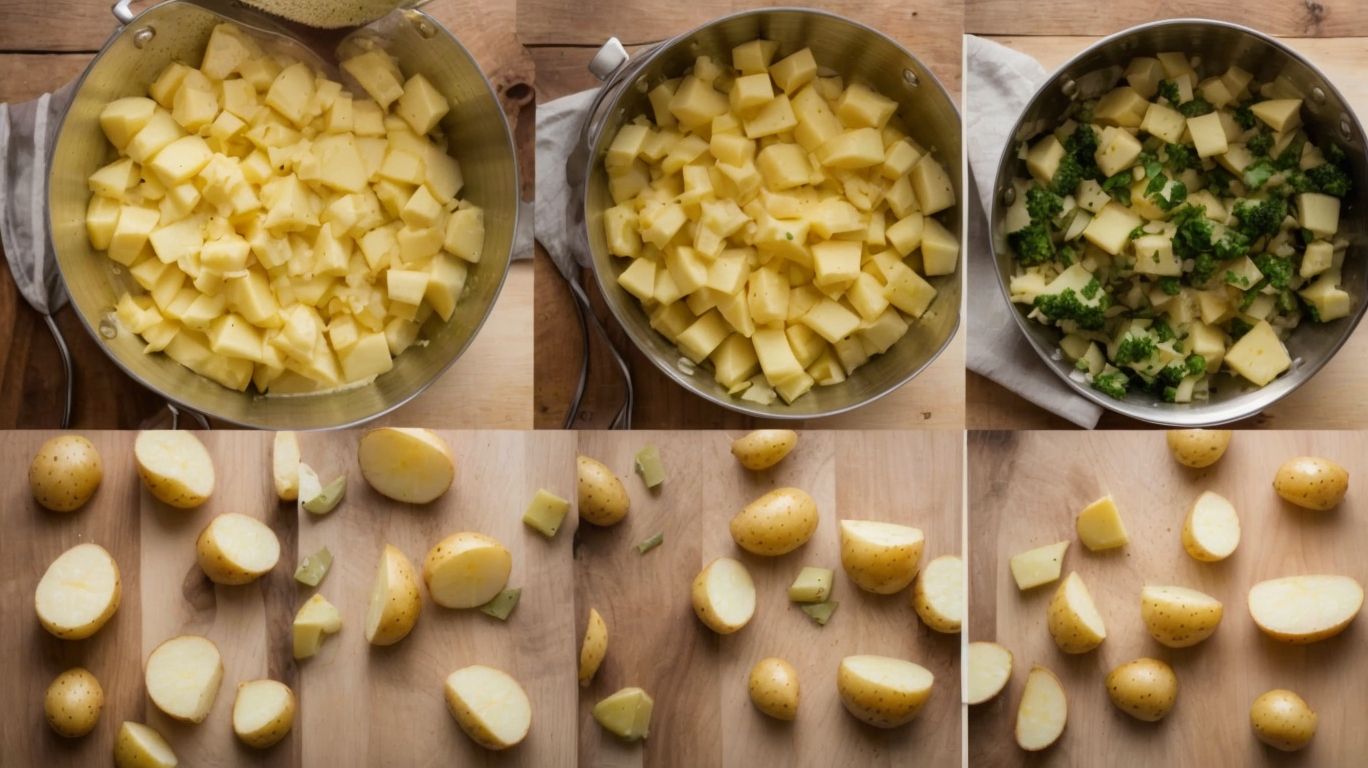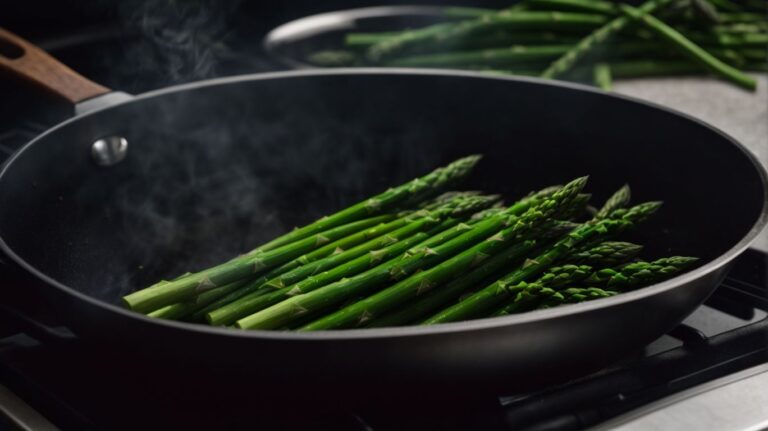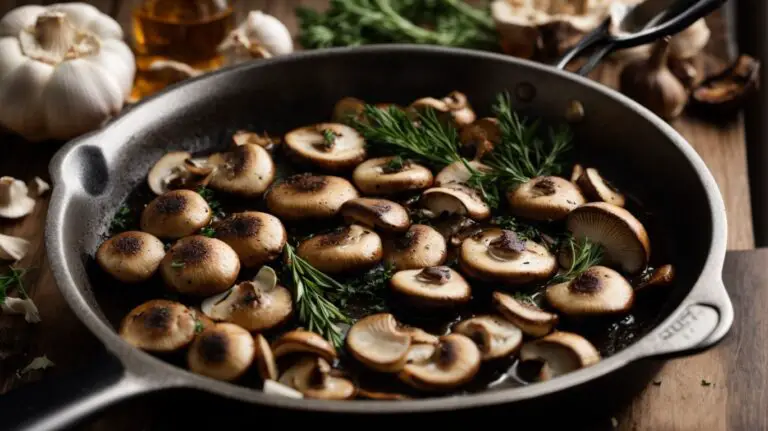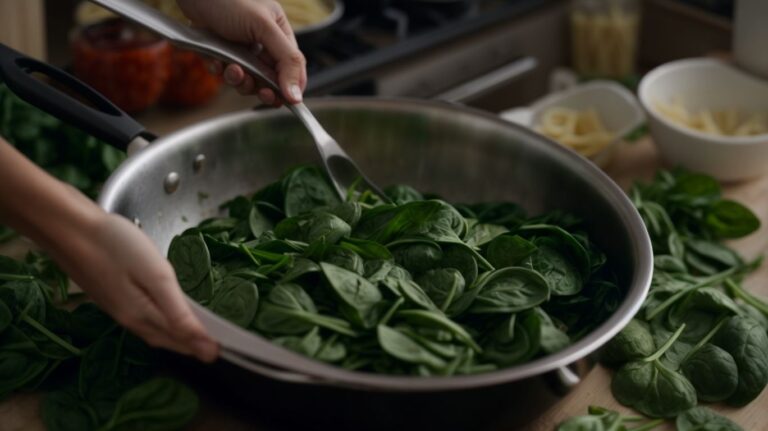How to Cook Potatoes for Potato Salad?
Potato salad is a classic dish loved by many for its creamy texture and delicious flavor.
We explore the different types of potatoes that are best for making potato salad, as well as the steps to prepare them perfectly.
Discover tips for making the perfect potato salad, including adding flavorful ingredients and balancing creaminess.
Get answers to common questions about potato salad, such as how long it lasts in the fridge and if it can be frozen.
Join us as we learn how to cook potatoes for the ultimate potato salad!
Key Takeaways:
What is Potato Salad?
Potato salad is a classic dish made with boiled potatoes dressed in a flavorful mixture of ingredients such as vinegar and creamy salad dressing.
One of the key components that gives potato salad its distinctive taste is the incorporation of crunchy vegetables like celery, onions, and pickles, which provide a refreshing contrast to the soft texture of the potatoes. Herbs such as dill or parsley are often added to enhance the flavor profile.
This versatile dish can be customized to suit individual preferences, with variations that include adding hard-boiled eggs, bacon, or even mustard for an extra kick of flavor. Whether served as a side at a summer barbecue or as a main course for a light lunch, potato salad remains a beloved choice among food enthusiasts.
Why is Potato Salad a Popular Dish?
Potato salad has gained popularity as an American-style side dish due to its versatility, ease of preparation, and suitability for various meal occasions.
Its enduring appeal lies in the delightful combination of creamy potatoes, tangy mayonnaise, crisp vegetables, and flavorful seasonings that create a refreshing accompaniment to a range of dishes.
The beauty of potato salad is its adaptability; whether it’s a casual gathering, a picnic in the park, a summer barbecue, or a holiday feast, this dish seamlessly complements the main course.
This classic favorite can be customized to suit different tastes and preferences, with variations like classic American potato salad, German potato salad with a vinegar-based dressing, or a creamy, herb-infused rendition.
Types of Potatoes for Potato Salad
In terms of making potato salad, selecting the right potatoes is crucial. Common choices include Russet potatoes, Yukon gold, and red potatoes, each offering unique textures and starch levels.
Russet Potatoes
Russet potatoes are a popular choice for potato salad due to their fluffy texture and ability to absorb flavors well when prepared using suitable cooking techniques.
When making a potato salad, utilizing Russet potatoes can provide a satisfying result due to their high starch content. This attribute not only contributes to their signature fluffy texture but also aids in absorbing the delicious dressings and seasonings, ensuring each bite is full of flavor. To enhance the flavor absorption process, it’s advisable to boil the Russet potatoes whole and unpeeled before cutting them into cubes. This method helps the potatoes retain their shape and absorb the seasoning more effectively, resulting in a tastier potato salad overall.
Yukon Gold Potatoes
Yukon gold potatoes are prized for their creamy texture, making them a popular choice for potato salad.
Choosing the right dressing for your Yukon gold potato salad can greatly impact its overall taste. Consider a mix of mayonnaise, Dijon mustard, vinegar, and fresh herbs for a flavorful and creamy dressing that complements the potatoes perfectly.
Incorporating ingredients like crispy bacon, hard-boiled eggs, green onions, and a hint of tangy pickles can add layers of texture and taste to your salad. To showcase the natural sweetness of Yukon gold potatoes, try roasting them with olive oil, garlic, and rosemary before mixing them into your salad.
Red Potatoes
Red potatoes are ideal for potato salad recipes that require serving the dish cold or at room temperature, as their waxy texture holds up well during the cooking process.
Due to their firmer and creamier texture, red potatoes are less likely to fall apart or become mushy when boiled, making them perfect for cold salads. When preparing a potato salad, it’s important to cut the potatoes into uniform pieces to ensure even cooking. Boil the red potatoes until they are just tender enough to pierce with a fork, being careful not to overcook them as they can quickly turn mushy. Once cooked, let them cool before mixing with other ingredients to retain their shape and texture.
Preparing Potatoes for Potato Salad
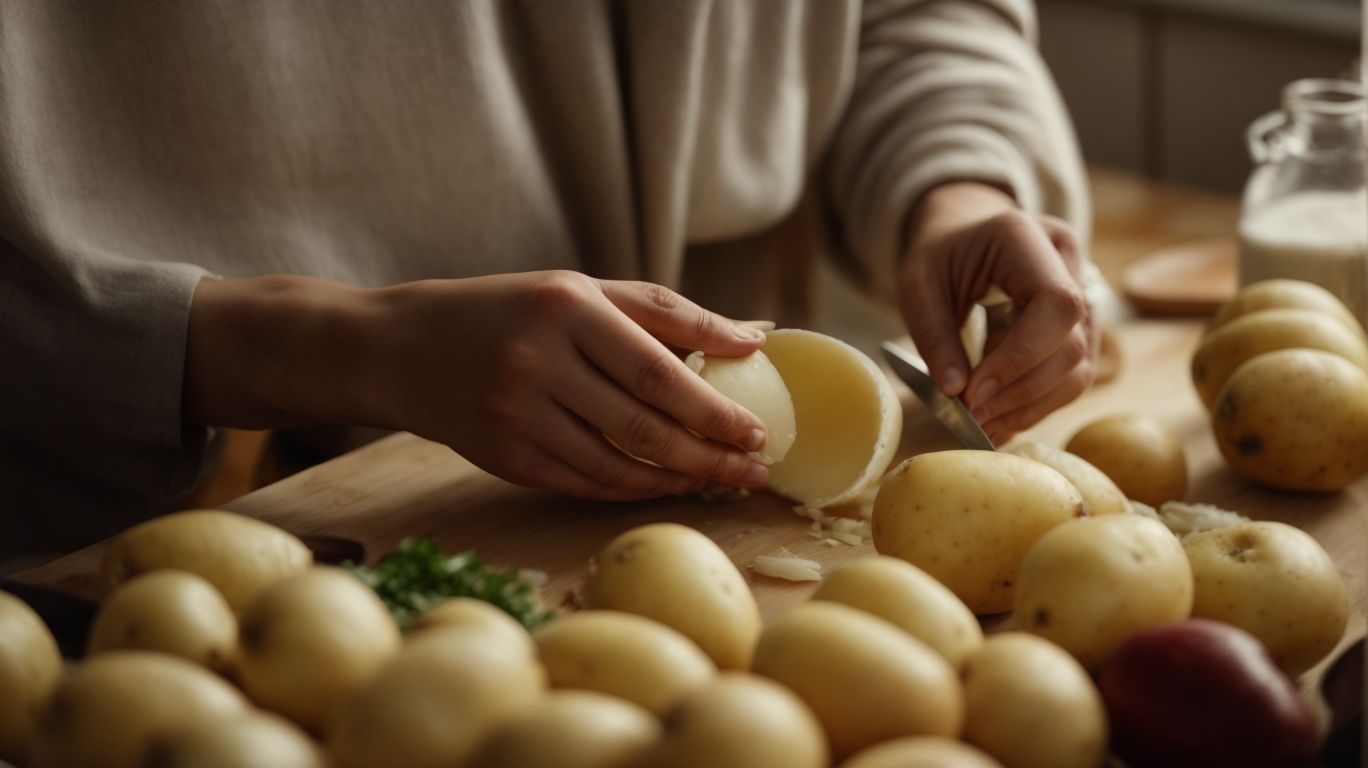
Credits: Poormet.Com – Dennis Campbell
Before assembling a delicious potato salad, proper preparation of the potatoes is essential. This includes steps such as peeling, cutting, and boiling the potatoes to achieve the desired texture and flavor.
Peeling Potatoes
Peeling potatoes is a fundamental step in potato salad preparation, requiring the use of kitchen tools such as peelers to remove the potato skins efficiently.
When peeling potatoes, it is essential to choose the right peeler: a Y-shaped peeler is great for smooth-surfaced potatoes, while a swivel peeler works well with uneven surfaces. Peeling the potatoes not only enhances the appearance of the final dish but also removes any blemishes that may affect the taste. The thickness of the peeled layer can impact the potato salad texture; thinner peels might absorb more dressing, adding flavor throughout, while thicker peels can provide a rustic feel.
Cutting Potatoes
Cutting potatoes into uniform pieces is crucial for even cooking and texture consistency in potato salad.
When diced potatoes are similar in size, they cook at the same rate, preventing some from being undercooked while others are mushy. To achieve this, aim for ½ to ¾ inch cubes for your potato salad. After slicing the peeled potatoes into uniform rounds, stack the rounds and slice them into strips before dicing them into small cubes.
- Ensuring consistency in diced potatoes also enhances the visual appeal of the dish, making it more appetizing.
- Consistent cuts make it easier to achieve the desired texture in your potato salad, avoiding any unpleasant surprises.
Boiling Potatoes
Boiling potatoes is a critical step in potato salad preparation to ensure they are cooked to the right level of tenderness. Monitoring cook time and using adequate boiling water are essential for cooking perfect potatoes.
For optimal results, it’s recommended to start with cold water and add the potatoes before turning on the heat. This gradual increase in temperature helps the potatoes cook evenly. Once the water reaches a gentle boil, reduce the heat to maintain a simmer. Avoid rapid boiling as it can cause the potatoes to break apart. Testing the potatoes with a knife or fork is a reliable way to check for doneness – they should offer slight resistance but not be mushy.
Cooling Potatoes
After boiling, cooling potatoes is crucial in potato salad preparation to prevent them from becoming mushy.
Different salad variations and homemade recipes can incorporate cooled potatoes for added texture and flavor. For example, a Mediterranean potato salad might include cooled potatoes mixed with olives, tomatoes, feta cheese, and a light lemon vinaigrette. Alternatively, a classic potato salad with a mayo-based dressing benefits greatly from using properly cooled potatoes, ensuring a deliciously creamy yet firm texture. The cooling process not only preserves the potato’s integrity but also allows the flavors of other ingredients to meld together harmoniously.
Tips for Making the Perfect Potato Salad
Crafting the perfect potato salad involves artful consideration of ingredients for flavor, achieving the ideal creaminess level, seasoning to taste, and knowing the best practices for serving and storing the salad.
Adding Flavorful Ingredients
Enhancing potato salad with flavorful ingredients such as vinegar can elevate its taste profile.
While vinegar adds a tangy kick and helps cut through the richness of potatoes, it’s crucial to consider the recipe variations for a personalized touch. For instance, apple cider vinegar lends a sweeter note compared to white or red wine vinegar. Adjusting the cooking temperature when boiling the potatoes plays a vital role in flavor development. Gentle simmering ensures the potatoes cook evenly without turning mushy, preserving their natural flavors for a delectable outcome.
Balancing the Creaminess
Achieving the perfect level of creaminess in potato salad is a delicate balance that avoids common cooking mistakes and ensures an appealing texture that enhances the overall dish.
One of the key factors to keep in mind is the texture of the potatoes themselves. Overcooking potatoes can lead to a mushy consistency, which is a common pitfall in potato salad preparation. It is essential to maintain the potatoes’ firmness to achieve the desired creaminess. Incorporating the dressing gradually and gently folding it into the potatoes helps to evenly distribute the flavors without breaking down the potato chunks. By paying attention to these details, you can elevate your potato salad to a new level of deliciousness.
Seasoning the Salad
Seasoning potato salad with the right blend of spices and salad dressings can make a substantial difference in its taste. Vegetarian recipes and optimal cooking temperatures can cater to diverse preferences.
In terms of enhancing the flavor of a potato salad, choosing the right herbs and spices plays a pivotal role. For vegetarian options, consider using fresh herbs like parsley, dill, or chives to add a burst of freshness. Ingredients like lemon juice or apple cider vinegar can provide a tangy twist to your salad dressing.
To ensure that your potato salad is not only delicious but also safe to eat, it’s essential to pay attention to the cooking temperatures. Vegetarian recipes often highlight the importance of proper food handling and storage practices to maintain the integrity of the dish.
Serving and Storing the Salad
Properly serving and storing potato salad is essential for maintaining its freshness and flavors. Understanding its role in meal preparation and as a versatile side dish can enhance the dining experience.
In terms of serving potato salad, it is crucial to keep it chilled until ready to be served to prevent bacterial growth. Serving it at room temperature for extended periods can pose a risk to food safety.
As for storing leftover potato salad, always refrigerate it promptly in an airtight container to maintain its quality and prevent it from spoiling.
Consider adding a sprinkle of fresh herbs or a squeeze of lemon juice when serving to elevate the flavors and provide a delightful culinary experience.
Frequently Asked Questions about Potato Salad

Credits: Poormet.Com – Roger Perez
Addressing common queries about potato salad can provide clarity on preparing and storing this beloved dish. From making it ahead of time to freezer storage and exploring recipe variations, these FAQs cover essential aspects of potato salad enjoyment.
Can I Make Potato Salad Ahead of Time?
Preparing potato salad ahead of time is a convenient meal preparation strategy, allowing flavors to meld and intensify for a more enjoyable homemade dish.
By making potato salad in advance, you not only save time on busy days but also give the ingredients ample time to marry together, resulting in a more cohesive and delicious flavor profile. This advanced preparation method is particularly beneficial for meal planning, as you can have a ready-made side dish or light meal option on hand, reducing stress during hectic periods. Homemade versions of potato salad benefit greatly from the extra time, as the flavors have time to merge into a harmonious blend, elevating the overall taste experience.
How Long Does Potato Salad Last in the Fridge?
Potato salad can typically last for a few days in the fridge when stored properly, ensuring that the salad dressing and ingredients maintain their freshness for continued enjoyment as a delightful side dish.
When storing potato salad in the refrigerator, it is crucial to keep it in an airtight container to prevent it from absorbing any odors or flavors from neighboring items. The type of salad dressing used plays a significant role in shelf life; creamy dressings tend to last shorter periods than vinaigrettes due to their dairy content.
Ingredients like hard-boiled eggs or mayonnaise-based additions can shorten the salad’s longevity. To extend its freshness, fresh herbs and acidic ingredients such as lemon juice can act as natural preservatives. Remember to stir the salad before serving to redistribute the flavors and maintain its delicious taste.
Can I Freeze Potato Salad?
Freezing potato salad is possible but may alter the texture and consistency upon thawing.
When considering freezing potato salad, it’s important to be aware that freezing can result in a change in the texture due to the moisture content in the potatoes. To minimize these changes, one option is to opt for a mayo-free potato salad or to use a dressing that can withstand freezing better. Another way to preserve the salad is by adding ingredients with more robust textures, such as crispy bacon or crunchy pickles, which can hold up better after thawing.
How Can I Add a Twist to Traditional Potato Salad?
Incorporating innovative twists into traditional potato salad recipes can introduce exciting new flavors and textures, enhancing the culinary experience and offering diverse meal preparation options.
One creative approach to elevate your potato salad game is by experimenting with different types of seasonings and herbs. Think beyond the classic mayo-based dressing and consider using a tangy vinaigrette or a zesty avocado-based sauce for a modern twist. Swapping out the usual white potatoes for sweet potatoes or purple potatoes can add a unique color and flavor profile to the dish.
Frequently Asked Questions
1. How to Cook Potatoes for Potato Salad?
To cook potatoes for potato salad, start by washing and peeling the potatoes. Then, cut them into bite-sized cubes and place them in a pot of cold water. Bring the water to a boil and let the potatoes cook for about 10-15 minutes, until they are fork-tender. Drain the potatoes and let them cool before using in your potato salad recipe.
2. Can I use any type of potato for potato salad?
Yes, you can use any type of potato for potato salad, but some types may work better than others. Russet potatoes tend to fall apart when boiled, so they may not hold up well in a potato salad. Yukon gold or red potatoes are better options as they hold their shape and have a creamier texture.
3. Should I cook the potatoes with the skin on or off?
This is a matter of personal preference. Keeping the skins on can add more texture and nutrients to the potato salad. However, if you prefer a smoother and creamier potato salad, it’s best to peel the potatoes before cooking them.
4. How long do I need to cook the potatoes for potato salad?
The cooking time can vary depending on the type and size of the potatoes. It’s best to test the potatoes with a fork after about 10 minutes. If they are easily pierced, they are done. If not, continue cooking for a few more minutes until they are fork-tender.
5. Can I make the potato salad ahead of time?
Yes, you can make the potato salad ahead of time, but it’s best to wait until just before serving to mix in the dressing. Keeping the potatoes and dressing separate will prevent the salad from becoming too mushy.
6. How do I prevent the potatoes from getting mushy in potato salad?
To prevent the potatoes from getting mushy, it’s important to not overcook them. Test them with a fork after 10 minutes and continue cooking if they are not yet fork-tender. Also, make sure to let them cool before mixing them with the dressing, as hot potatoes can cause the dressing to break down and make the salad mushy.

